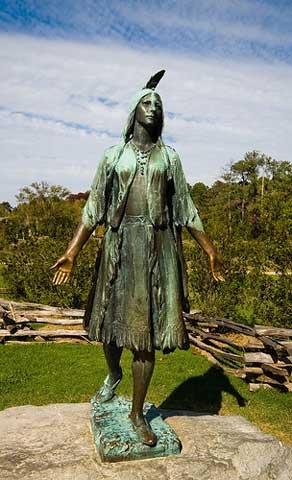National parks and historical events which occurred at those sites have provided the setting or the inspiration for dozens of movies, as Bob Janiskee has previously discussed on the Traveler. Fame can be a mixed blessing for the staff of the featured parks, however, as employees at Colonial National Historical Park learned a few years ago when Hollywood decided to bring Pocahontas to the big screen.
Just in case it's been a year or two since your last American History class, here's a quick review to set the stage for this story.
In May 1607, three shiploads of adventurers landed at Jamestown and established the first permanent English settlement in North America. Virginians like to point out that event was thirteen years before passengers aboard the Mayflower landed at a place named Plymouth.
Jamestown is now part of Colonial National Historical Park. Pocahontas and Captain John Smith were among the real-life cast of characters in the early history of the site, although neither legend nor popular literature has tended to paint a very accurate picture of their relationship. When Hollywood came calling in the 1990s with plans for a movie about Pocahontas, the park staff had hopes that the resulting film would help tell this story in a way that would capture the interest of a new generation.
Well, capture interest it did, but artistic license was alive and well when the film began showing all across the country. For the next year or so, the beleaguered staff at Jamestown had their patience sorely tested by zany, movie-inspired inquiries. After all, if people saw it on the Big Screen, it must be true!
Jamestown is located on a flat, swampy island barely above sea level in southeastern Virginia. The mix of tidal marshes and wooded areas gives the island a special beauty of its own, but the terrain has about as much elevation variation as a slightly warped tabletop. The setting in the film, including soaring cliffs and plunging waterfalls, looks more like the Columbia River Gorge than the mid-Atlantic coast. The result was a small army of rather confused visitors to the actual site, who understandably had a hard time locating those scenic wonders they’d seen in the movie.
Some of you reading these words probably thought at one time or another that you’d enjoy life as a park ranger, or at least felt a tinge of envy for those who are fortunate enough to spend their working years in that job. If that’s the case, put on your imaginary ranger uniform and take a stroll with me around historic Jamestown.
It’s a very warm and steamy summer afternoon and you’re tempted to take off that trademark, flat-brimmed Stetson hat and fan your damp brow, but that would be bad form, because here comes a nice family with a question for the ranger. A quick glance at their red, sweaty faces confirms that mom, dad and their 6-year-old have spent quite a while roaming the grounds, and it’s obvious that they have a question. Well, probably several questions.
Dad is clearly frustrated and glances down at his young daughter. “Hey, there’s a park ranger. Why don’t you ask her your question, because she’ll certainly know the answer.”
Smile and brace yourself, because you can make a pretty good guess about what’s coming next.
“Ms. Ranger,” implores the little girl, “we’ve been looking all over, and we can’t find the talking tree anywhere!”
It’s true that the real Jamestown does have a lot of trees, but none of them are the movie version of a centuries-old mystical spirit who lived in a very ancient tree. When the Hollywood Pocahontas needed some advice or a little encouragement, this talking tree was just the place to go.
While you’re pondering an appropriate answer, your little visitor tosses in a follow-up: “And by the way, we also haven’t seen the talking raccoon.”
There’s probably a logical answer to that one, too, but not one you could use with a first-grader.
Uh-oh, here comes another group, so I’ll just leave you with this family to answer their daughter’s questions. As an aspiring ranger, I’m sure you’re up to the task.
Meanwhile, I suspect the latest arrivals will have a question or two about the mystery of the missing waterfall.
Maybe it’s hiding behind the talking tree.
This story is adapted from the book Hey Ranger 2: More True Tales of Humor and Misadventure from the Great Outdoors © Jim Burnett and Taylor Trade Publishing, used by permission.


 Support Essential Coverage of Essential Places
Support Essential Coverage of Essential Places







Comments
It's really sorry that Hollywood cannot get history right. Why is it they always have to put garbage into their films? Why can't they just make a movie with just the real facts? It's really too bad our children have to learn their history through films that don't portray real life as it was.
I agree with the previous post...Often real history is more interesting and exciting than the Hollywood version...if it's done right.
Thank you for the article, it made me laugh. I worked at Jamestown last summer and the movie questions were of constant humor for us. So...when did Pocahontas marry John Smith? Really, she was 11? I was fond of that rather large pagoda oak in the civil war earthenwork next to the fort though. Perhaps we will call that the talking tree...
Thanks for your comment ... and for keeping your sense of humor on the job :-)
It's amazing how long questions persist after the movie's release, but it still shows up regularly on various TV channels, so I guess you're seeing a whole new generation of Pocahontas fans - and their questions !